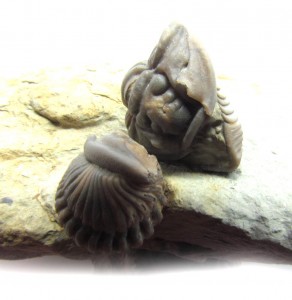Making a Meaningful Fossil Collection
Collections of anything are a good thing in teacher-land. Collections lead kids to learn. My favorite things to collect are fossils, rocks and minerals. This morning, when I began to reorganize the special new “finds” from my recent trip to Tucson, I got to thinking about all the different ways a person could go about setting up a collection. Here are just a few ideas that may help you get started.
Fossils
Lots of people have one favorite kind of fossil. If you want to take a look at what happens when you REALLY get into one type, just check out this website: http://www.trilobites.info/ Dr. Gon III must truly love trilobites. I’ve been visiting his website for years and I still haven’t discovered everything he has to teach about trilobites. I’ll be he has a great collection, too!

That’s just one way to get going on fossil collecting: choose your favorite fossil and begin to collect individual specimens that represent different species, time periods and locations. I have several trilobites in my collection and they represent both early specimens from the Ordovican in the Midwest USA and Devonian in Morocco. As I am able, there will be more sophisticated…and expensive…specimens to add to my collection, but in the meantime, I have a nice group of trilobites to demonstrate all that I’ve learned about this extinct creature.
As you become aware of the time periods in which your fossil lived, you might want to begin to collect a specimen from each of the time periods since life began to flourish on the Earth. Lately, I’ve enjoyed adding to my Time Line of Life Fossil collection with some unusual little guys.
I started my TLL (that’s short for Time Line of Life) collection with a stand-alone purchased fossil collection. My first one came from Ohio and the fossils were not very spectacular. But they got me started. Next I found a set that had 12 nice quality specimens and some general information cards. As I found more places to get really good fossils, I made my own 12-piece and 18-piece collections and now they are for sale here: https://www.fossilicious.com/fossil-collections/ The 18-piece collection is my favorite because it has a wide range of species and nearly every geologic period represented.
The thing is that once I set up the 18 specimens according to the geologic time scale, I wanted to add in specimens from the missing periods…like the Triassic or the Precambrian. I went searching for specimens from these time periods and I made some great finds.
A few years back, I found Triassic petrified wood from Madagascar. These were really cool because unlike a lot of petrified wood pieces, which are beautiful, but also look like lots of other “jasper-like” rocks, you can see the design of the tree bark.
I think I may be on to finding a new type of fossil to collect: stromatolites. Stromatolites are fossils formed by cyanobacteria. There are stromatolites that are so old they may have been responsible for changing the atmosphere into the oxygen-rich air we breath today. That’s an oversimplification, of course, but some of my more recent finds include the pale green stone called Butterstone that is 2.5 billion…that’s right, billion… years old and is known to have stromatolites in its layers. Besides the incredible color variations, the rock is naturally creamy in texture. It is a great little piece to fidget with because it feels so smooth and soft.

Then there’s the stromatolite that comes from South America. (Butterstone comes from Africa.) It is a completely different color: shades of dark brown, almost black, with bands of light brown. I especially like the carved balls and spheres. They are pretty heavy and the polish makes them feel really good in your hand. They’re pretty old, too: 2.2 billion years!
I have pieces in my collection that I found myself, a small collection of different kinds of brachiopods just because I like them, and a very small collection…almost too small to call it a collection…that contains parts of a crinoids: the holdfast that kept in tied to the ocean floor, a variety of different-sized stems and the crown or head from which the delicate fronds grew.
Of course, you don’t HAVE to organize your fossil collection in any way at all! You can just begin with a few small finds, mark them down with location, species and other pertinent info (you can find sample cards, here: http://www.fossilicious.com/fossil-collection-labels.html) and keep them on a stand or in a box.
It’s really simple…so get out there and get started!





